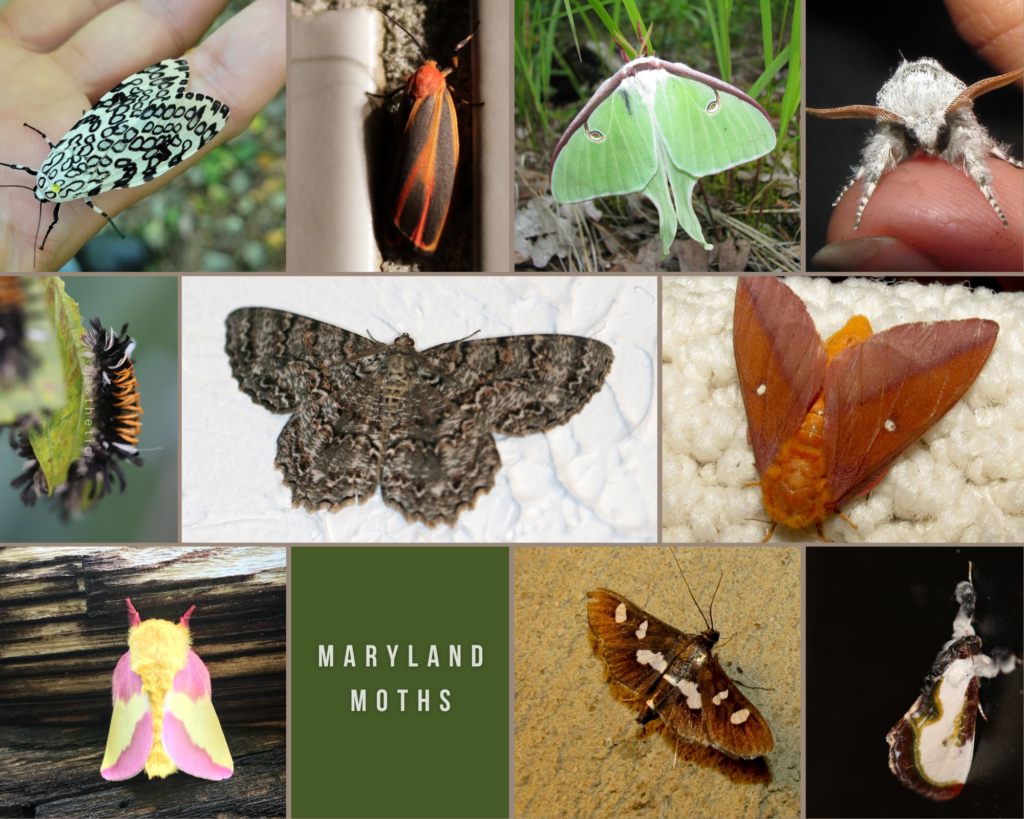How to Host a #MothParty

Today is the end of the 12th annual #NationalMothWeek which is designed to “celebrate the beauty, life cycles, and habitats of moths.”
Like many, I believe the first moth that captivated me was the Luna moth, but my quest to learn about all things nature led me to realize how vast the world of moths actually is. In fact, there are over 12,000 species of moths in North America, over 2,700 of which have been documented in Maryland. Wow!

I casually observed moths for a number of years, enjoying ones that came to the porch lights or checking out the wonder that was the moth haven at Oak Barrel Café on I-68 while making a pit stop to western Maryland. (The café was right by a wildlife corridor and its bright lights were extremely attractive to all things moth, but they have since switched out their light source to one that is less attractive to insects.) Several times, I participated in BioBlitzes which included running moth sheets at night to document nocturnal insects. I never considered trying it out on my own until the pandemic.
In May of 2021, the vaccine had rolled out, and it was deemed safe to be outside with people. So, several of us met up at the Delaware coast to view the annual horseshoe crab breeding event. It was a blast! I decided the next nature nerd adventure should be to celebrate National Moth Week in July. I went low tech. I bought a white bedsheet and a blacklight off of Amazon and invited a couple people to come over. I figured at the very least, we had snacks! We had fun, and news spread on Facebook after the event… so I decided I should make it a recurring adventure.
In 2022, I grabbed a second blacklight, made a Facebook event page, and hosted two nights of mothing. On the first night, we had an unexpected visitor: a female Hercules beetle, our largest native insect in Maryland which also is just gorgeous. We also had this annoying dark brown beetle that we dubbed the “coffee bean” beetle that kept flying into people and flailing on the ground. After snapping a few pics for ID, I tossed the “coffee bean” into the woods so it didn’t get stepped on… turns out, that was the hermit flower beetle and a county record! On the second night, we had more moth visitors and just as much fun.
Flash forward to 2023, we again hosted two nights of mothing. On the first night, a male Eastern Hercules Beetle made an appearance and on the second night, we had an invasion of the less-welcome European hornets.

Ingredients for a Successful Party:
- White sheet; a bedsheet is fine!
- A light source– blacklights are the cheapest/easiest to find. Lower wavelength lights are the most attractive. You can also get a UVA/UVB reptile lamp relatively easily. Mercury vapor lights are some of the best lights to use, but they are more expensive and harder to find.
- Bug jars– to view what you caught a little easier and/or to “contain the threat” aka contain some night flying social wasps like European hornets that show up on occasion.
- ID guides– iNaturalist is pretty good for AI-generated ID, but a book like Peterson’s guide to Moths of Northeastern North America and Art Evans’s guide to Beetles of Eastern North America are good to have on hand to look for smaller characters you might need for ID
- Optional but recommended: a group of friends, snacks, and a sense of wonder 😊
In general, mid-June through July are good times of the year to ‘moth’ in our area as those times coincide with most of the major adult flights. I highly suggest using resources like iNaturalist to upload your sightings as they go into a community database to examine trends and populations across the globe. Species like moths tend to be understudied and underreported, so moth parties are a great way to help increase our local knowledge of these species.
Of course, mothing also highlights the need to make our spaces more moth-friendly to encourage and support these important species. A few things you can do in your own backyard to help include:
- Turn off outdoor lights at night. It’s fine to use lights for mothing to document species but do be mindful of how many nights in a row you run in the same spot. Put outdoor lights on timers and sensors to reduce the amount of light pollution occurring in your yard. Birds, bats, moths, and more will all benefit!
- Plant native plants. Moths need to lay their eggs on plants as nursery for their young. If you don’t have the right nursery habitat, then you can’t support the lifecycle of our local moths. Like butterflies, moths can host on trees, shrubs, and flowers, and they can nectar off of them, too!
- Leave the leaves. Do you love wooly bears? If so, they and several other moth species need leaf litter to overwinter within. Without it, they won’t have winter habitat and can’t pupate into adults the following spring. Leaf litter is best in garden areas under host/nectar plants.
- Reduce pesticide use. Many pesticides like mosquito sprays can affect other species, too. Work to reduce attractants like standing water, monoculture lawns (that are nursery for Japanese beetles), etc. Use pesticides sparingly, in accordance to manufacturer’s directions, and with other non-chemical control means.
- Spread the word about moths. Moths are underrated. Butterflies usually get most of the attention, but we have lots of gorgeous and important moth species, too. Fun fact: because some moth species are fuzzier, they actually are better pollinators than many butterflies which are good at drinking nectar but not so good at transporting pollen.
Don’t forget: the little things run the world. – E.O. Wilson